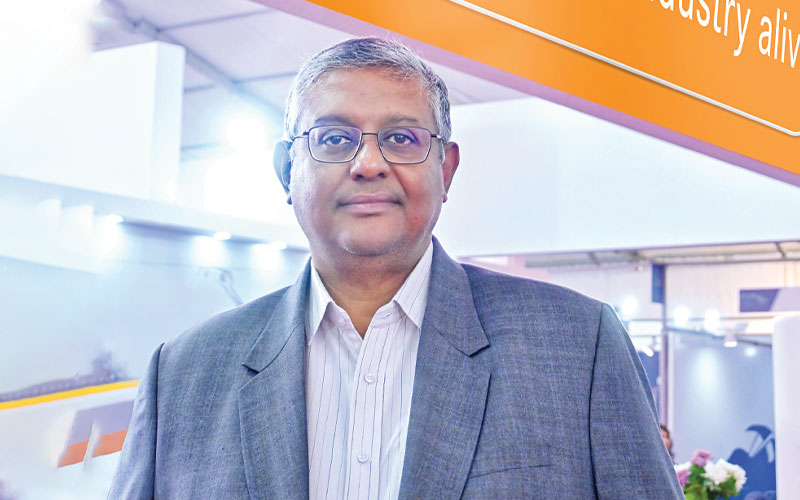Going by the tagline- ‘We keep your industry alive’, LAPP is focusing on transitioning itself from being a mere product company to an end-to-end solution provider. As part of their commitment to India and foreseeing huge growth potential here, the group plans to make Bhopal unit as its single-largest global manufacturing facility by establishing a new plant for low voltage power control and instrumentation cables. It also targets to double its Indian business in the next three years. This was revealed by LAPP India’s newly appointed Managing Director, Mr. Sumit Mitra, during an exclusive interaction with Wire & Cable India.

Wire & Cable India: As you step into this new leadership role, what key priorities have you set for both short-term and long-term growth of LAPP India?
Sumit Mitra: I’m really excited to join LAPP. In the global context, India has been a very strong market for LAPP. We’ve been very successful in the country in the last few years and the growth is expected to continue in the coming years. We have put ourselves on this scorching pace and plan to almost double our business here in the next three years for which we are working on multiple initiatives in different directions. We are very much invested in India and plan to continue this way.
We are building a great team for LAPP in India. The company is focusing on putting the right kind of manufacturing and engineering capabilities, including investments in new capacities. In our quest to further grow our business, we are exploring multiple segments and exciting new areas, such as semiconductor manufacturing, factory automation & digitalization, data centers, and energy storage.
As we enter this next phase of growth for LAPP globally, we are moving away from being a product company to an end-to-end solution provider. The decision follows the mega trends that are shaping our world right now. When we talk about digitalization becoming a big part of our ecosystem, it does not remain limited to a data center, but extends to include digitalization of factories, as well as smart buildings.
WCI: How do you envision LAPP India advancing in terms of product innovation and technological integration?
SM: Innovation is in LAPP’s DNA and a very important part of our business. We are taking some very distinctive paths in terms of innovation. We are focussing on having the right products specific for the Indian market, while trying to be cost-effective. The Indian market has a huge growth potential, but the requirements for performance are quite high. We are looking at ways to become cost-competitive, which calls for its own set of innovations. You can’t just take out a product from Europe and plug it in India. You need to have some localization. Whether it is about the development of local polymers or manufacturing processes, we are looking at ways to improve them.
Another aspect is engineering innovation. We are working on providing to our customers, end-to-end engineering solutions.
Watch: Top Cable Companies in India
WCI: What kind of initiatives have you taken to make your operations more sustainable and what you intend to take in future?
SM: LAPP has a multi-pronged approach towards sustainability. When it comes to sustainability, LAPP is working with BASF, a chemical company. An important component is the use of bio-based plastics. LAPP is coming up with Organic ETHERLINE, the first Ethernet cable with a bio-based TPU sheath material (thermoplastic polyurethane) sourced from BASF, which was previously based on fossil raw materials. The bio-based plastic used is Elastollan® N. It is a corn-based biopolymer. Depending on the type of TPU, the proportion of renewable raw material is 45 to 60%. We are also exploring end-to-end recycling for cables. Since cable has a lot of copper, it has great potential for recycling, and we look forward to introducing something on those lines in future. Currently, it’s a work in progress.
LAPP is an ISO certified company, making efforts to incorporate sustainability and recycling into its building operations and manufacturing processes. We are looking at ways to reduce our absolute power consumption and increase the efficiency of our ecosystem, while working on green energy. Further, we are working on initiatives to optimize our whole supply chain and make it more efficient.
We are aligning our products with sustainable solutions. We are a significant player in the renewable energy sector, manufacturing very specific products for segments such as solar energy, wind energy and energy storage solutions. Our products are perfect for applications in outdoor, high temperature and harsh working environments.
There is another part to sustainability, which is about the impact that we make on society. We are doing a lot of work in terms of education and healthcare.

We are very much invested in India and plan to continue this way.
WCI: Tell us about your manufacturing facilities in India, with special focus on expansion in the Bhopal plant.
SM: We have three manufacturing facilities in India, at Jigani in Karnataka, Bhopal in Madhya Pradesh and Dharuhera in Haryana. We started operations in India in 1996 by setting up a state-of-the-art manufacturing unit at Jigani in Bangalore, and doubled its production area in 2014. The plant is currently running at almost full capacity.
Dharuhera unit is a small facility, where we are manufacturing some very specialized products and accessories, which were not part of our traditional portfolio.
Run in an extremely impressive way, the unit at Bhopal is the only LAPP facility in India having scope for expansion right now, where we are coming up with a large plant for low voltage power control and instrumentation cables. The Bhopal unit is going to be the single largest manufacturing facility for the LAPP globally.
WCI: What is the future of the wire and cable industry, both at the Indian and international level?
SM: The future for wire and cable is fantastic. If you look at the global scenario, one of the main reasons for this is increasing digitalization and electrification of the actual physical infrastructure. As we move towards a future having more electrically-operated instruments and gadgets, it promises robust demand and growth for cables and wires.
When it comes to India, there is a second layer to it. India is currently the highest GDP growth country globally, which means the demand will remain. Besides, the Railways sector is taking some real revolutionary steps in terms of modernizing the fleet- including the locomotives, intercity trains, Vande Bharat trains, as well as the metros. Apart from that, the Railways is investing on signaling and safety, which spells into rising demand for cables and wires. Other segments which are growing include the steel industry which is targeted to achieve a crude steel capacity of 300 million tonnes by 2030–31. With new investment coming up in steel, I think it is giving a big growth impetus to India, which is on top of the global digitalization trend. This is a great time to be in this industry. Apart from this there is a continued investment in other infrastructure as well as increasing foreign investments and growing Indian investments in new facilities.
Also Read: HFCL Rewrites Playbook for Future-Proof Network Connectivity
WCI: How do you intend to position LAPP in the Indian context?
SM: LAPP was previously more of a cable manufacturer for different applications. Giving true justification to its tagline, ‘We keep your industry alive’, LAPP is focusing on becoming an end-to-end solution provider, which means LAPP will now supply connectors, active devices, passive devices and junction boxes, everything that is required for a communication network. Most of these capabilities are being developed in-house and some will be manufactured in collaboration with certain partners.
Our focus has been on two areas- One is increasing the amount of Indian manufactured products, owing to initiatives like ‘Make in India,’ which have drastically reduced imports. The second is we are working on a strategy to have a portion of the value added internally within the company. We are strongly focused on the whole sustainability paradigm, which is end-to-end. It’s not about how we make or deliver our products, but about how we run our operations.
LAPP believes that going forward is not possible without people. The company lays a lot of emphasis on team building and people development. I think this is for me personally, the most satisfying part of my job, because there is a huge scope in terms of developing our people not just from technical capabilities, but from the leadership capabilities, so that they can all step up to take these larger roles within our organization as we grow.

The future for wire and cable is fantastic. If you look at the global scenario, one of the main reasons for this is increasing digitalization and electrification of the actual physical infrastructure.
WCI: Please tell us about your market footprint and the industries served by you.
SM: Traditionally, LAPP was into manufacturing instrumentation cables and control cables. We now have the full range of capabilities in terms of instrumentation, control, data and power cable. LAPP India is a leader in cable and connection technology, which provides fieldbus technology, optical transmission systems, industrial connectors, glands, conduits, cable markers, tools, and accessories. The 40,000 products in our global catalog reflect our manufacturing prowess. LAPP products are used in production machinery, industrial robots, public transport, food processing, alternative energy, charging systems for electric vehicles, oil drilling platforms and many more.
With the installation of E-beam, we have extended our range of products to newer segments coming in India, such as semiconductor, e-mobility, rail infrastructure, ship-wiring, nuclear plants, defense, solar power, aerospace, automotive and medical sectors.




